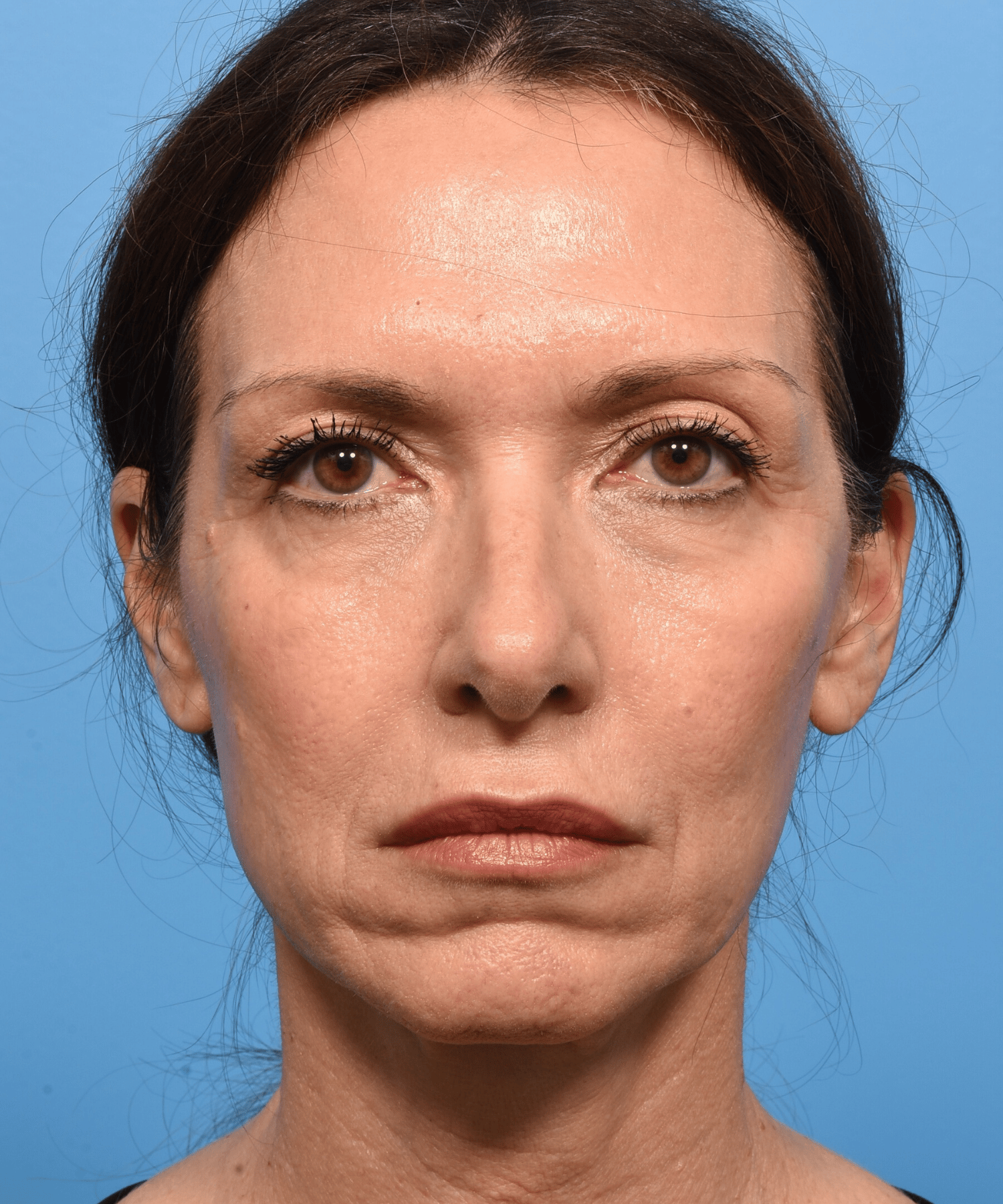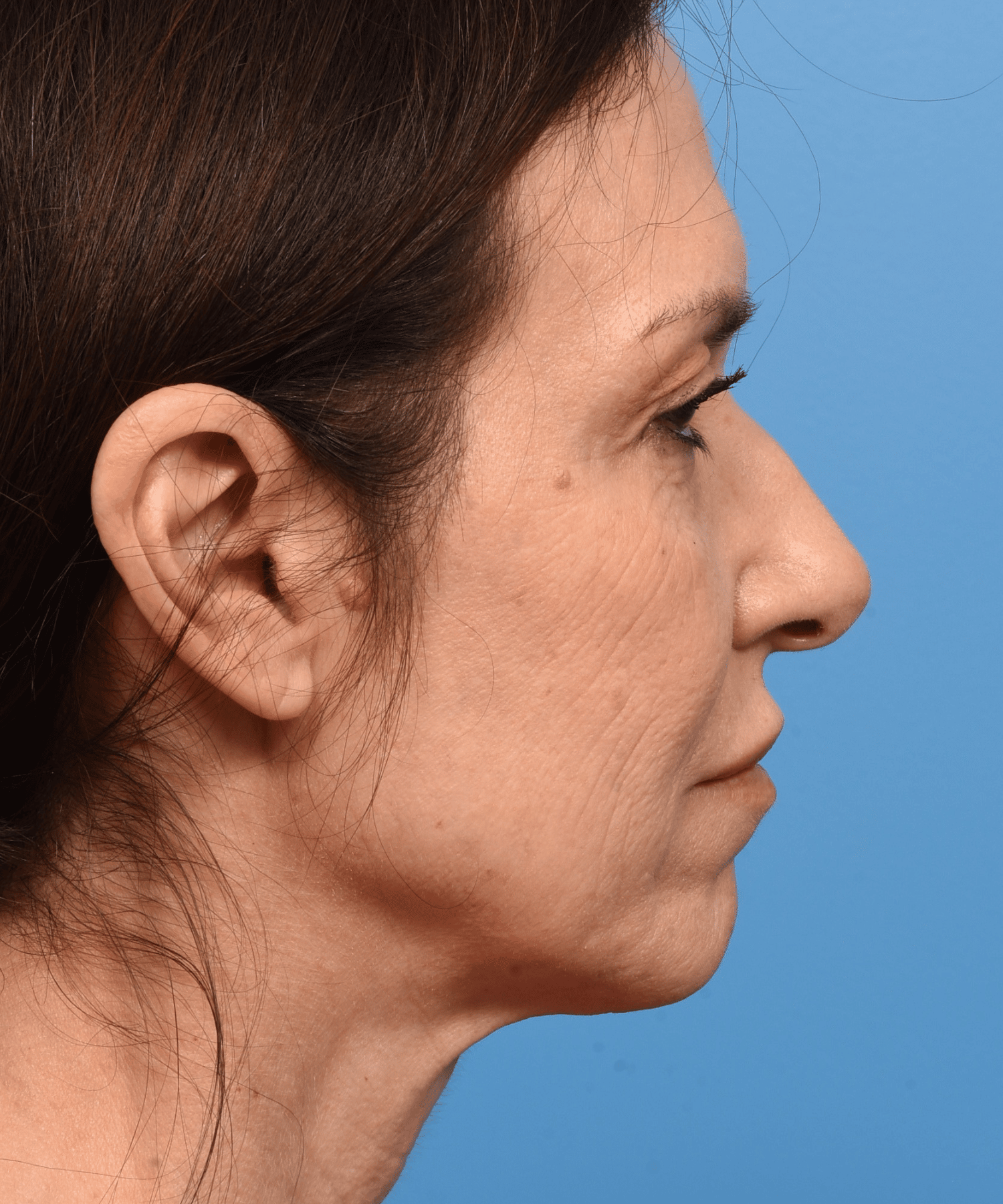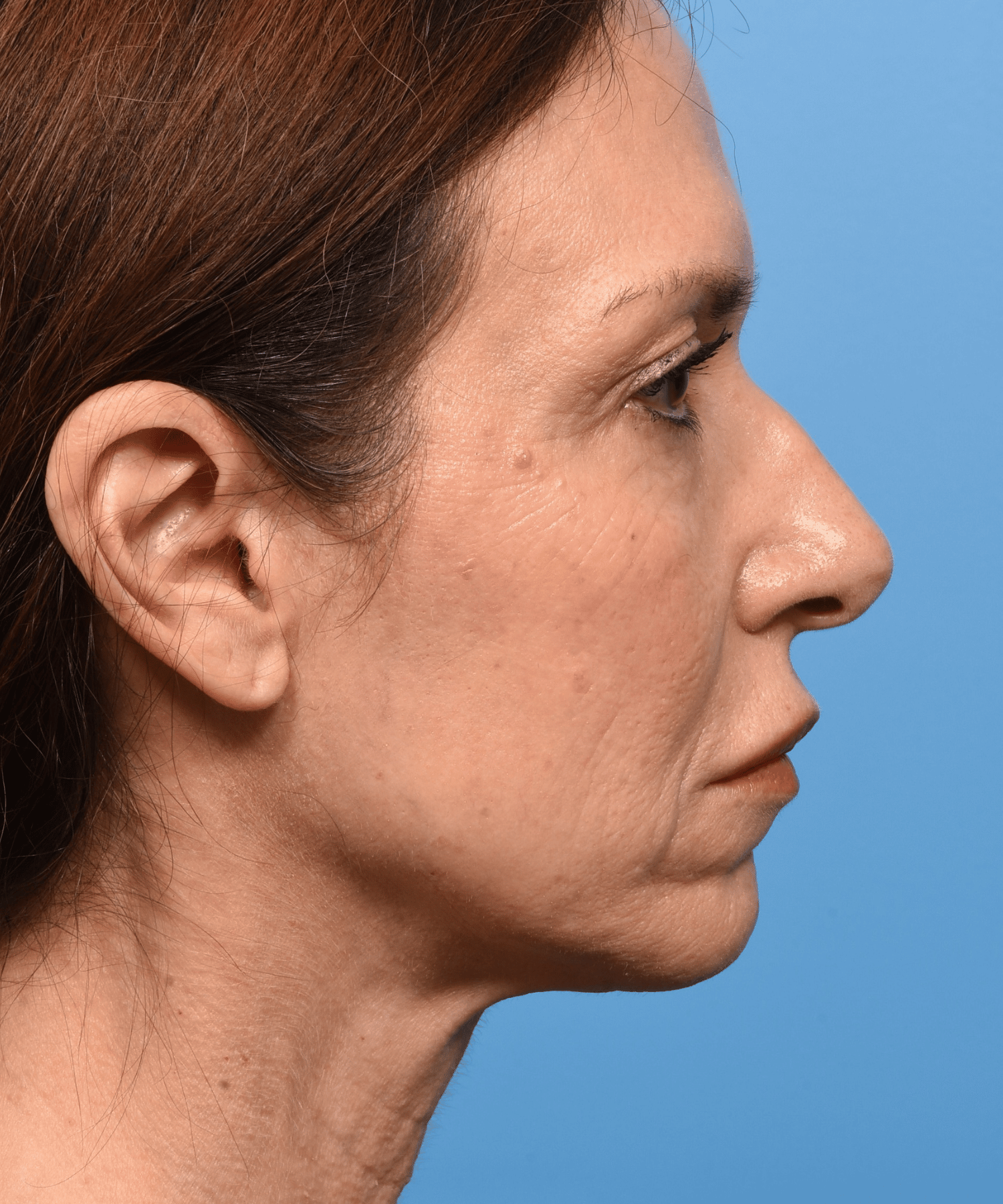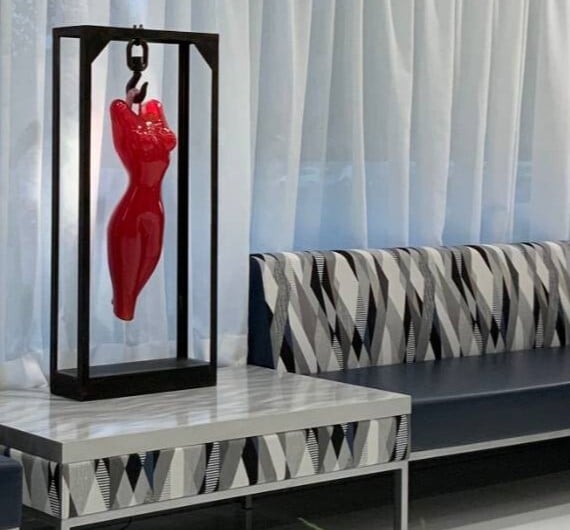*Individual results may vary
Time, sun exposure, gravity, and the stresses of daily life take their toll on our faces: deep creases appear beside the mouth, the jawline slackens, and fat deposits and folds appear on the neck. A facelift can reverse sagging skin and other signs of aging and give your face a refreshed and youthful look.
At Mark D. Epstein, MD, FACS Plastic & Aesthetic Surgery, we help you feel your best and become your most confident self. If you've been wondering whether a facelift might fit you, we invite you to learn more by reading the information below and scheduling a consultation with us to discuss your options.
What is a facelift?
A Facelift, or rhytidectomy, is a surgical procedure to address issues including wrinkles, skin folds, and fat deposits by tightening skin and muscles and removing fat, thus giving your face a youthful, fresher look. After surgery, some patients appear ten to fifteen years younger.
As the face ages, we develop lines due to muscle pull, lines due to atrophy of the deeper layers of our skin (loss of volume), wear and tear on the surface of the skin, sagging of facial structures, and stretched excess skin. A facelift helps mainly with the last two on the list: sagging skin and excess skin.
Facelift surgery can also restore volume to portions of the face, not changing the thickness of our skin but rather repositioning structures on the face. Botox best treats fine lines and wrinkles due to muscle pull, and lines due to loss of volume may be treated by injectable fillers or surgery.
We believe that you know your body best, and it's important to us that you're in charge of your care. We're proud to treat each patient as an individual, and we'll work to create an individual care plan to create your desired look.
Facelift Before & After

Before

After

Before

After

Before

After
What procedures can be combined with a facelift?
A facelift can be combined with other facial surgical procedures such as a browlift, eyelid surgery or nose reshaping (rhinoplasty) for more dramatic results. Incisions are made in inconspicuous places such as behind the hairline and in the natural folds of the face and ears, and scars fade to near invisibility in time.
What a facelift will improve
- Deep creases under the eyes
- Midface sagging
- Deep creases between the nose and mouth (nasolabial folds)
- Jowling due to loss of volume/sagging of facial structures
- Excess areas of fat
- Loose skin and fat under the chin and jaw and neck
What a facelift won’t do
Facelifts can produce a dramatic improvement in appearance for patients with the problems mentioned above. However, facelifts do not stop the aging process; in time, signs of aging will gradually appear once again. Further, facelifts will not rejuvenate the brow, eyelids, nose, and some of the midface.
Patients who want to improve these areas may consider combining a facelift with a brow lift or eyelid surgery (blepharoplasty). Injectable soft-tissue fillers, facial implants, and skin resurfacing can also enhance the effects of a facelift.
Patients who smoke, take medications or have certain medical conditions such as high blood pressure, blood clotting problems, or the tendency to form excessive scars should discuss potential risks with their surgeons. Patients with short hair may consider letting it grow before surgery to conceal scars better.
Facelift Candidates
Ideal candidates for a facelift include:
- Wish to improve one or more of the signs of aging indicated above
- Are men or women whose faces have begun to sag but whose skin still has some elasticity
- Are generally healthy
- Do not smoke
- Have realistic expectations
- Are considering a facelift for personal reasons, not because someone else is pressuring you to do so
It is also important to note that while the results of a facelift are long-lasting, oftentimes ten years or more, the results are not permanent. As you age and collagen production slows down, your face may eventually start to sag in certain areas.
Facelift Procedure
Facelifts are usually outpatient procedures and may be performed in an office-based facility, surgery center, or hospital, typically under local anesthesia combined with a sedative. The procedure itself varies depending on the surgeon and the patient’s facial structure (i.e., where the incisions are placed, whether one or both sides of the face are worked on at once, in which order the steps are performed).
In most facelifts, incisions are made from the temples down in front of the ears and sometimes also back behind the earlobe to the lower scalp. The surgeon lifts the skin, suctions fat, tightens muscle, trims excess skin, and then stitches the incisions closed.
Sometimes, metal clips are also used to hold incisions firmly closed on the scalp, and bandages are often wrapped around the head to reduce bruising or swelling. Patients may temporarily need a thin surgical drainage tube which is placed behind the ear. This is usually removed the following day.
Facelifts are typically outpatient procedures and may be performed in an office-based facility, surgery center, or hospital. Patients may have a choice of IV sedation or general anesthesia. The procedure takes about two hours. This does not include ancillary procedures such as eyelift, browlift, or rhinoplasty, all of which may be performed at the same time as rhytidectomy.
Facelift Incision Techniques
The way a facelift is performed varies depending on the surgeon, the patient’s facial structure, and the extent of correction desired.
The three most common incision techniques for a facelift include:
- Traditional facelift: The “full” facelift for rejuvenating the face, jowls and neck, including fat sculpting, lifting and repositioning of muscle and deeper tissues, and skin trimming and redraping. The incision begins at the temples and travels down to the front of the ear, around the earlobe, and behind the ear to the lower scalp at the hairline. Sometimes, another incision is made under the chin.
- Limited-incision facelift: For limited rejuvenation around the eyes and mouth, including nasolabial folds and other deep creases. Short incisions are made at the temples and around the ear, and possibly in the lower eyelids and/or under the upper lip as well.
- Neck lift: A neck lift concentrates on jowls, loose skin on the neck, and fat under the chin. The incision is made around the ear lobe and behind the ear to the lower scalp.
Common Facelift Techniques vs MACS
Traditional facelifts are similar in that they all bring the facial and neck skin upward and back. This necessitates an incision behind the ear to take up the slack from the excess skin and permit excision of it. However, gravity does not pull our skin down and forward, merely down. So why pull the skin back? It simply makes no sense at all. Have you ever seen someone with a “bad facelift”?
Maybe they have a tight, windblown look about them? The reason they are “bad facelifts” is because you can recognize them. It is possible to have a natural-looking facelift, with results that last as long as any of the other techniques, with less visible scarring, less risk of complications, and less downtime.*
One of the reasons for forming a bad scar is wound tension. The tighter a wound is closed, the stronger the forces upon it to pull it apart. Although most wounds do not pull apart, as the wound is healing, these constant forces of distraction cause the forming scar to widen, often taking a thin, hard-to-see scar to one that is unsightly. So, how do you get a good lift from a facelift if you cannot put tension on the skin closure? The answer is the MACS lift.
MACS stands for Minimal Access Cranial Suspension. Sounds complicated, but it's simple. Personally, I can’t believe it took so long for plastic surgery to discover this technique. Interestingly enough, it was developed by two friends and colleagues of mine, Drs. Patrick Tonnard and Alexis Verpaele, in Gent, Belgium, who were actually early in their careers when they developed this procedure.
They have written two excellent textbooks on the subject, and having read both and visited with them in their operating room in Belgium, I will try to highlight the procedure in lay terms.
What is a MACS facelift?
The MACS lift is a pure vertical lift. Skin is pulled straight up, not back. This means that you are directly reversing the pull due to gravity and eliminating the need, in all but the most severe cases, for an incision behind the ears. The facial structures are lifted not by the skin, but by a series of either two or three pursestring sutures in the face. This is not a thread lift, the longevity of which is only about one year or so. If you picture a change-purse, like the one my grandmother had, when you cinch down the pursestring, the circle becomes smaller, tightening the bag.
The first suture loop, or purse string, is placed along the side of the face, from a point in front of the ear to the upper neck and back again, forming a narrow, long loop. When the suture is tightened, the neck is tightened and elevated. The second loop is oval-shaped and starts at the same point in front of the ear as the first loop, then passes around the cheek and back again.
This suture, when tightened, brings up the anterior cheek, flattens the nasolabial fold (the “parentheses” or smile lines), and adds volume to the cheeks. The last suture, considered optional, but I like it in almost everyone, starts just lateral to the outer corner of the eye and passes down to the malar fat pad. This is the pad of the upper cheek, just below the outer eye. This suture brings fullness back to the upper cheek over the cheekbone.
All three loops are anchored to the deep connective tissue of the face (the “cranial suspension”) using a smaller skin incision (the “minimal access”). Furthermore, the neck does not need to be opened with an incision; rather, liposuction of the neck is done, whereas before, a more formal neck opening was required.
At this point, the face is lifted. So what about the skin? The excess skin is marked and removed so that when removed, its cut edge lies right on top of the edge of the skin on the other side of the wound. This ensures that there is no tension on the wound, which in turn results in a fine, very hard-to-see scar.
In fact, the design of this procedure puts the scar back behind the hairline by a few millimeters so that the scar heals behind the hairline! As an aside, less skin needs to be lifted off the face, and the surgery takes place further away from the delicate nerves of the face that work our muscles of facial expression, making the surgical procedure less risky overall!
Ancillary procedures such as eyelift and browlift can be performed at the same time to augment the results of the procedure. Less scarring, more natural, better scars, and less risky. Ever hear the old saying, “quick, easy and cheap?” You can have any two but not all three”? Well, here you can have all three!
Facelift Surgery Recovery
After your rhytidectomy, Dr. Epstein will wrap the incisions in bandages and may place drainage tubes in the area. The tubes will be taken out the next day at your “clean-up visit”. There will be some swelling and maybe some bruising as well.
Any numbness, bruising, or thin hair around the scar will fade in a few weeks; bandages, stitches, and clips are removed within a day to a week. Most patients are back on their feet in a day or two, although the face may appear distorted and feel stiff, and many return to work within one to two weeks.
At first, you should be gentle with your skin and hair, and men may need to shave behind the neck and ears where areas of beard-growing skin have moved. In addition to being located in inconspicuous places such as behind the hairline and in natural folds of the face and ears, scars fade considerably in time.
Initially, you may experience swelling, numbness, bruising, and a feeling of tightness or tension in the face and neck. Your face may look uneven or distorted, and your facial muscles may feel stiff. Most of these usually resolve within 3-6 weeks, and sensation typically returns to normal within a few months.
Scars become less red, raised, lumpy, or itchy in time. Many patients return to work by the third week. Camouflage cosmetics can be used to minimize the appearance of bruising. You should be gentle with your skin and hair as you recover. Men may need to shave behind the neck and ears where areas of beard-growing skin have moved.
Facelift Results
The results of a facelift only last for a while; you may want to have another procedure in five or ten years. But in another sense, the effects are long-lasting; years later, your face will continue to look better than if you had never had the procedure.*
We'll work with you to recommend procedures in the meantime that can help support your new look.
Complications and Risks
Facelifts are generally safe procedures. Most people who have a facelift do not experience complications. That being said, it's important to be aware of the potential risks of your surgery to make an informed decision as to whether a facelift is the right choice for you.
Possible complications of a facelift include bleeding, infection, bruising, uneven swelling or discoloration, allergic reaction to the anesthesia, skin blistering (usually only seen in smokers), and temporary or permanent loss of sensation in the face. Dr. Epstein will discuss the risks and benefits of a facelift with you before your surgery.
Complications are rare but may include hematoma, temporary or permanent nerve injury, infection, and allergic reactions to anesthesia. If you experience a complication, we're here to work with you and develop a treatment plan to help you feel your best.
Read what our patients are saying!
" Everything Was Handled In A Prompt Professional Manner And Fully Explained Ahead Of Time."
Click here to read more reviews.
Mark D. Epstein, MD, FACS Plastic & Aesthetic Surgery: Call Us Today
At Mark D. Epstein, MD, FACS Plastic & Aesthetic Surgery, our team is here to help you feel confident and comfortable in your own skin. Whether you've had aesthetic or plastic surgery in the past, or it's your first time considering a procedure to help you love the way you look, we'll be with you every step of the way.
We're currently accepting new patients, and we'd love to talk with you about how we can help you get the look that you want. Contact us at 631-597-8627 today to schedule a consultation!


